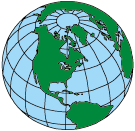 Geography: Places, Terms and
Definitions
Geography: Places, Terms and
Definitions
Goals:
- The students will locate countries and major cities on a map
of the lands bordering the Atlantic Ocean, gaining a familiarity
with the lands talked about in Kidnapped and Treasure
Island.
- The students will gain familiarity with vocabulary used in
Kidnapped and Treasure Island.
- The students will measure and calculate distances on a map
using a map scale.
- The students will convert the measured distances to nautical
miles.
- The students will create a topographic map.
- The students will place distances in nautical miles into a
table as another form of organizing data.
Resources:
- Kidnapped by Robert Louis Stevenson. Adapted by Bob
Blaisdell. (Dover Publications, 1996)
- The blank world map with the students' labeled countries from
the
Treasure
or Not? lesson
- Maps and Mazes by Gillian Chapman and Pam Robson (The
Milbrook Press, 1993)
- The Internet can also be used to find conversion figures from
nautical miles to miles. The number of miles in one nautical
mile is 1.15077944802354 miles.
- World maps, or continent maps should be available for the
students to reference. These maps or books with maps should have
country names, capitals and topography available for student use.
- Dictionaries or social studies books should also be available.
- Pens or Pencils
- Crayons, Markers or Colored Pencils
Time:
This lesson should run somewhere between two and three hours.
Procedure:
- The students will have read Treasure Island.
- Hand out the maps and ask students to use any resources (i.e.
world maps, atlases, social studies books) to find country names
and capitals. Write those names on their maps.
- Use topographic maps and have students create their own
topographic maps of the ocean and the shoreline maps using the
maps from the
"Treasure
or Not?" lesson with the countries and capitals. Include the
topography of the oceans also. (Direct instruction may be needed
in creating topographic maps. The best way to show students how to
make a topographic map may be through a specific example showing
students the topographic scale with its various colors and the
color of the map due to different elevations.)
- Give a list of vocabulary words the students should know with
respect to geography. This list may include words such as gulf,
sea, peninsula, island, and strait.
- Students find the definitions of these words along with a
specific example from their created maps. (This could also be done
in a table.)
- Have students calculate the distance to various capitals on
their created map and then covert it to nautical miles. Make sure
students show their work!
- Using their calculations, students will put the distances into
a table as another form of recording data. The table will look
something like the following example with the left hand column
being the origin of travel and the top row is the destinations.
All distances in the table should be in nautical miles. (REMEMBER,
this is just an example! Distances are not accurate!)
|
|
New York, New York
|
Lisbon, Portugal
|
Edinburgh, Scotland
|
|
New York, New York
|
0
|
2000
|
2200
|
|
Lisbon, Portugal
|
2000
|
0
|
300
|
|
Edinburgh, Scotland
|
2200
|
300
|
0
|
- Assign Kidnapped to be read carefully looking for
geographic places and vocabulary.
Assessment:
- Each person will hand in a map with the countries, major
cities, topography and a topographic scale. (Criteria for success
- Students will have X number of countries and major cities
located. The students will also have the topography of the entire
region, including bodies of water, colored correctly with a
topographic scale so other people reading the map will be able to
recognize each region's topography.)
- Students will turn in an example of each of the vocabulary
words. (Criteria for success = An example on their map that is
specifically designated as an example of the vocabulary words.)
The definitions and other examples can be used for future student
reference.
- Students will organize their distance data in an organized
manner using the table. (Criteria for success = Students will
place correct distances to different locations in the table.
Included with the table should be the student's steps in
converting miles to nautical miles. Partial credit will be given
for each correct step: finding correct distances in miles, using
the correct conversion factor to convert to nautical miles, and
finally calculating the number of nautical miles by
multiplication.)
Curricular Strands and Major Concepts:
- Social Studies - Learning the names and locations of
countries and capitals along with the topography of areas.
Students also learn geographic vocabulary.
- Math - Calculating distances from various cities along
with recording the data in a table.
- Language Arts - Reading Treasure Island and
beginning Kidnapped.
Possible Extensions:
- Have students graph the distances from one capital to several
other capitals.
- Have students graph a cross-section of the topography on a
line graph.
- Research facts about capitals or countries from any data
source.
Go to:
Schedule
and Summary of Lessons
Lesson Plans List

